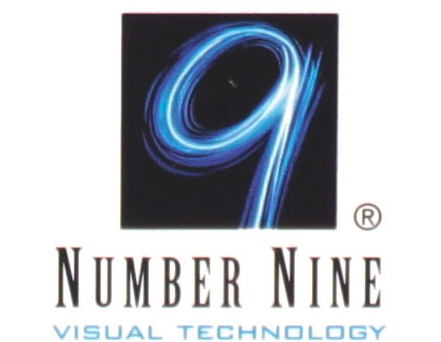 Number Nine / Number 9 / #9
Number Nine / Number 9 / #9
Number Nine was a graphics card manufacturer for the IBM PC and its compatibles based out of Lexington MA, USA. Started in 1982 by Andrew Najda and Stan Bialek as Number Nine Computer Corporation, the company was renamed in the early nineties to Number Nine Visual Technology Corporation.
Their first hardware was a MOS 65c02 microprocessor-based accelerator board for the Apple II. The company went on to develop another using the NEC µPD7220.
In 1984 they launched their first graphics card for the PC: the CGA-compatible Number Nine Graphics System. From that point up to around 1986 they produced a high-resolution family of cards by the name Revolution. They then entered into a partnership with Texas Instruments who had developed the TIGA (Texas Instruments Graphic Architecture) chip, TMS-34010, whereby Number Nine cards would host their own proprietary chip alongside this TIGA co-processor. This brought in Number Nine's second generation of cards, with the Pepper moniker. In 1990, the company began using TI's updated TIGA coprocessor, TMS-34020, with their GXi range, though the first of these (GX) still used the older TMS-34010.
In 1993, seeing there was still a strong market for more consumer-oriented graphics cards, they built a close relationship with S3, releasing SVGA cards that used a variety of S3 chipsets. The GXE range used the early S3 chips including 928, Vision864, Vision964 and the first Trio64 chip, 764. This relationship would continue with the release of Number Nine cards leveraging the ViRGE and Savage line of chipsets.
In 1994, Number Nine moved away from their relationship with TI for their high-end offerings, choosing instead to develop their own custom chips. This introduced the Imagine 128 family of cards, all of which sat on the PCI bus and were the first 128-bit graphics processors on the market.
In 1995 the company went public with half of its 9 million shares closely held. At that time they had OEM agreements with Dell, Gateway 2000, IBM, Intel and Microsoft.
In the mid to late 1990s, Number Nine lost market share due to price and performance competition from other video card makers, particularly Matrox, 3dfx, Diamond, and ATI. Number Nine had been slow to respond to the boom in 3D graphics, and had continued to emphasize high quality, fast 2D graphics.
In 1997, the company launched the first of their AGP-based cards, the Revolution 3D, though these were also sold in PCI bus form. The Revolution IV followed a year later.

Number Nine Visual Technology's corporate offices at 18 Hartwell Avenue, Lexington, MA.
In late 1999 the company filed for Chapter 11 bankruptcy protection from creditors and agreed to sell most of its assets to S3 for $4.8 million. In the agreement, most of Number Nine's employees would continue to work for S3, and the deal was concluded in June 2000.
Number Nine cards in chronological order:
| ISA Cards | VLB, AGP and PCI Cards |
|---|---|
| Professional Market Number Nine Graphics System (1982) Revolution 512x8 (1983) Revolution 512x32 (1984) Revolution 1024x8 (1985) Revolution 2048x4 (1986) Pepper (1986) Pepper SGT (1987) Pepper Pro 1024 (1988) Pepper Pro 1280 (1989) Pepper Pro 1600 (1990) GX (1990) GXi / GXi Lite (1990) GXiTC (1991) Consumer Market GXE (1993) |
Professional Market Imagine 128 (PCI, 1994) Imagine 128 Series 2 / 2e (PCI, 1995) Revolution 3D (PCI/AGP, 1997) Revolution IV / T2R IV / Revolution IV-FP (PCI, 1998) Consumer Market GXE (VLB/PCI, 1993) GXE64 (VLB/PCI, 1994) GXE64 Pro (VLB/PCI, 1994) GXE64 Pro 1600 (PCI, 1995) GXE64 Trio (VLB/PCI, 1995) Vision 330 (VLB/PCI, 1995) Motion 331 (PCI, 1996) Motion 531 (199x) Motion 771 (199x) Reality 332 (PCI, 199x) Reality 772 (PCI, 1996) Reality 334 (PCI/AGP, 1998) SR9 (AGP, 1999) |